Solubilization of algae and algal materials
a technology applied in the field of algae and algal materials, can solve the problems of the highest recoveries from the most expensive processes, and achieve the effects of enhancing the process for solubilizing algae and/or algal materials, and improving the solubilization ra
- Summary
- Abstract
- Description
- Claims
- Application Information
AI Technical Summary
Benefits of technology
Problems solved by technology
Method used
Image
Examples
Embodiment Construction
[0024]One aspect of the present invention is directed toward a method of solubilizing algae or algal material. The method includes providing algae or algal material and providing an oxoacid ester or thioacid ester of phosphorus or a mixture of an oxoacid or thioacid of phosphorus and an alcohol. A mixture of the algae or algal material and the oxoacid ester or thioacid ester of phosphorus or the mixture of the oxoacid or thioacid of phosphorus and alcohol is formed. The mixture is then treated under conditions effective to partially or completely solubilize the algae or algal material. The products resulting from such treatment may include lipids, oils, carbohydrates, proteins, fatty acids, hydrogen, carbon dioxide and other chemicals.
[0025]In general, the algae or algal material may be macroalgae, microalgae, diatoms or cyanobacteria and the treating step may be carried out at a temperature of 20 to 150° C., preferably at a temperature of 80 to 100° C. at a pH range of 1 to 9.
[0026...
PUM
 Login to View More
Login to View More Abstract
Description
Claims
Application Information
 Login to View More
Login to View More - R&D
- Intellectual Property
- Life Sciences
- Materials
- Tech Scout
- Unparalleled Data Quality
- Higher Quality Content
- 60% Fewer Hallucinations
Browse by: Latest US Patents, China's latest patents, Technical Efficacy Thesaurus, Application Domain, Technology Topic, Popular Technical Reports.
© 2025 PatSnap. All rights reserved.Legal|Privacy policy|Modern Slavery Act Transparency Statement|Sitemap|About US| Contact US: help@patsnap.com



